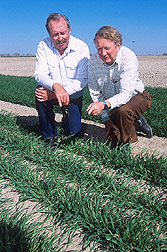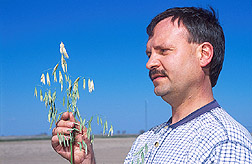New Oats and Barleys—Ready for Breakfast, Brewery, or Barn
|
|
| Oats are good for you! They're rich in fiber that can help lower cholesterol. They're also low in fat and are a good source of iron.
Besides furnishing the familiar, flattened flakes that we make into oatmeal for a warm, hearty breakfast, oats are also perfect for granola, pancakes, muffins, scones, breads, and of course that all-American favorite—oatmeal cookies. Oats or oat flour can be used as a thickener for soups, gravies, sauces, stews, or puddings. Toasted oats add a nutty taste and crunchy texture to salads. As a coating for fish, meats, or poultry before baking or deep-frying, they make a nice change of pace from wheat flour. |
|
|
|
Oats are good for animals, too. In barns and feedlots, oats are a healthy, protein-rich treat for horses and other livestock.
Last year, the U.S. harvest of 149 million bushels of oats was worth about $165 million to growers. For producers in the western United States, ARS plant breeders at Aberdeen, Idaho, are developing an array of new, top-performing oats. These varieties are part of the oat and barley breeding program at the ARS Small Grains and Potato Germplasm Research Unit in Aberdeen. More Oat Options for the West Headed by agronomist Darrell M. Wesenberg, the program is regarded as one of the best of its kind in the nation. New varieties from the research center are intended for producers not only in Idaho, but also in Montana, Washington, Oregon, Wyoming, and Colorado.
|
|
|
One new variety, Powell, results from lab, greenhouse, and field research by Wesenberg's team. The scientists collaborated with Lyle R. Bjornestad of the University of Wyoming and other colleagues in that state and in Idaho.
Powell thrives either in dryland or irrigated sites in the West, primarily in Idaho and Wyoming, and yields plump, cream-white kernels. When tested in Idaho and Wyoming, Powell produced greater yields than such leading commercial varieties as Otana and Monida. In addition, Powell was less susceptible to lodging—the tendency to fall overÑthan those two competitors. A new, hull-less oat, Provena, is directly linked to ARS-sponsored research on the East Coast and in the People's Republic of China. Provena's parentage includes an ARS-developed oat called Pennlo, bred in University Park, Pennsylvania, by now-retired ARS researcher Harold G. Marshall. Another Provena parent is a Chinese oat collected from Inner Mongolia more than 20 years ago during an expedition funded by ARS. Widely tested in the United States and Canada, Provena boasts good yields and impressive resistance to lodging. It's best suited for irrigated fields or regions that get plenty of rain during the April-through-August growing season. Western oat producers have another new option—Lamont, a hull-less spring oat. Good yields, notable resistance to lodging, and adaptability to a wide range of growing conditions make Lamont highly competitive with today's top commercial oat varieties. "There's interest in hull-less oats as high-quality feed for horses and dairy cattle," says Wesenberg. "But few if any hull-less oats have been well adapted to the western United States. Provena and Lamont should help fill that gap." What's next? A superb new oat that Wesenberg says may outproduce leaders like Otana. Wesenberg hopes to have this new oat, currently known by its research number—AbSP9-2, ready for growers next year. Better Barley for Brewing, Baking For some U.S. farmers, barley is another important crop. In 2000, American growers produced about 318 million bushels of barley, with a farm-gate value of about $632 million. Much of the barley grown in the United States is fed to livestock. Nearly half, however, is malted and used for making beer and other beverages, or candy bars and other sweets. After a process known as pearling, some barley ends up in the supermarket, perhaps positioned next to rice and pasta or featured as an ingredient of hearty canned soups. In home kitchens, fiber-rich pearled barley can be added to stuffings, or served as a side dishÑlike rice. At mills or bakeries, barley flour can be added to flours from other grains for baking. The Aberdeen team has bred a series of outstanding new barleys for the West. Among them is Garnet barley, for springtime planting. The Aberdeen breeders worked with ARS colleagues in Madison, Wisconsin, and university co-researchers, to develop Garnet. In yield tests, Garnet topped competitors like Harrington and Klages. Suitable as feed for beef and dairy cattle, Garnet is also proving ideal for malting and brewing. "Garnet has exactly what you want in a good malting barley," says Bernie Duenwald of ConAgra Malt Americas—the largest malting company in North America. "It's sweet, mellow, and not overly husky," he says. "It has a good, clean aroma, with no off-notes." Spring barleys need moisture from rain or irrigation throughout the spring-through-late-summer growing season. "But some dryland farms in western states don't get enough rain to consistently produce a high-value malting barley," says Wesenberg. New winter malting varieties, for fall planting where winter barleys are adapted, should sidestep that problem, he says. "Winter barleys are in the ground in time to take advantage of moisture from fall rains, winter snowpack, and early spring rainstorms," he explains. "On dryland farms, winter barleys sometimes yield twice as much as spring varieties." The Aberdeen scientists are currently evaluating several promising new winter malting barleys. One or two will likely be ready to release to breeders and seed producers by 2002 or 2003.—By Marcia Wood, Agricultural Research Service Information Staff. This research is part of Plant, Microbial, and Insect Genetic Resources, Genomics, and Genetic Improvement, an ARS National Program (#301) described on the World Wide Web at http://www.nps.ars.usda.gov. Darrell M. Wesenberg is in the USDA-ARS Small Grains and Potato Germplasm Research Unit, 1691 S. 2700 W., Aberdeen, ID 83210; phone (208) 397-4162, ext. 108, fax (208) 397-4165. |
|
"New Oats and Barleys—Ready for Breakfast, Brewery, or Barn" was published in the August 2001 issue of Agricultural Research magazine. |
|









